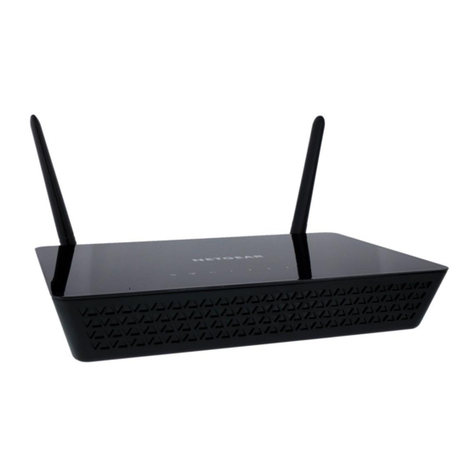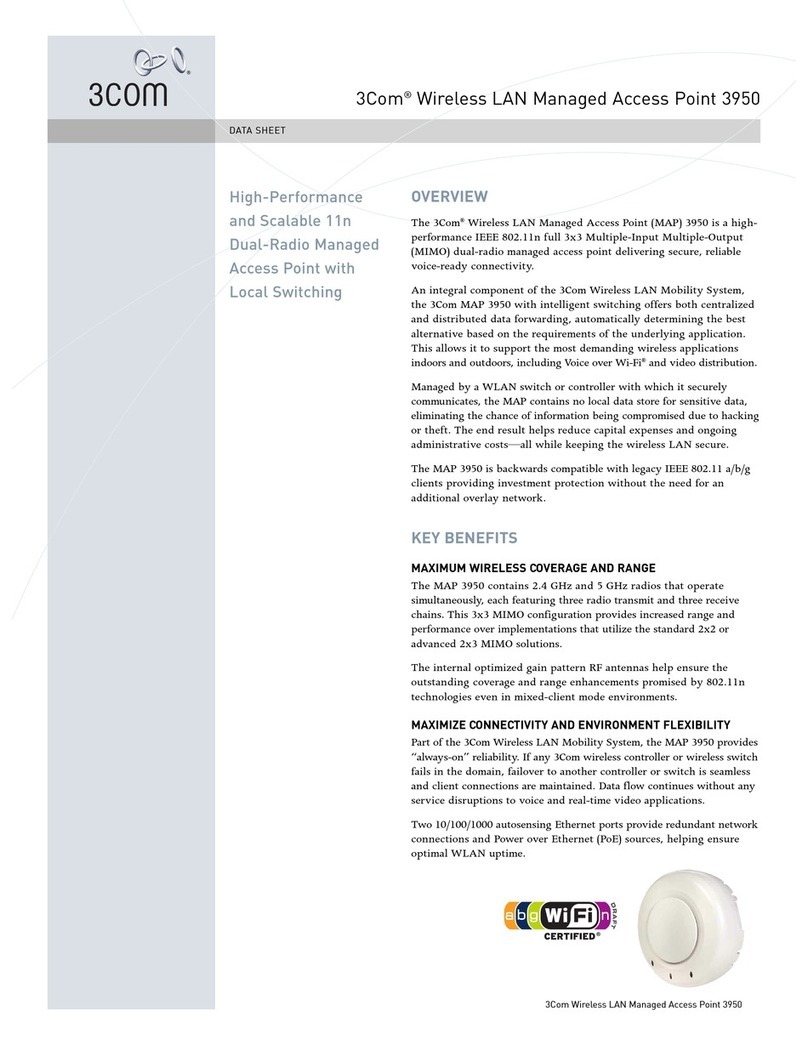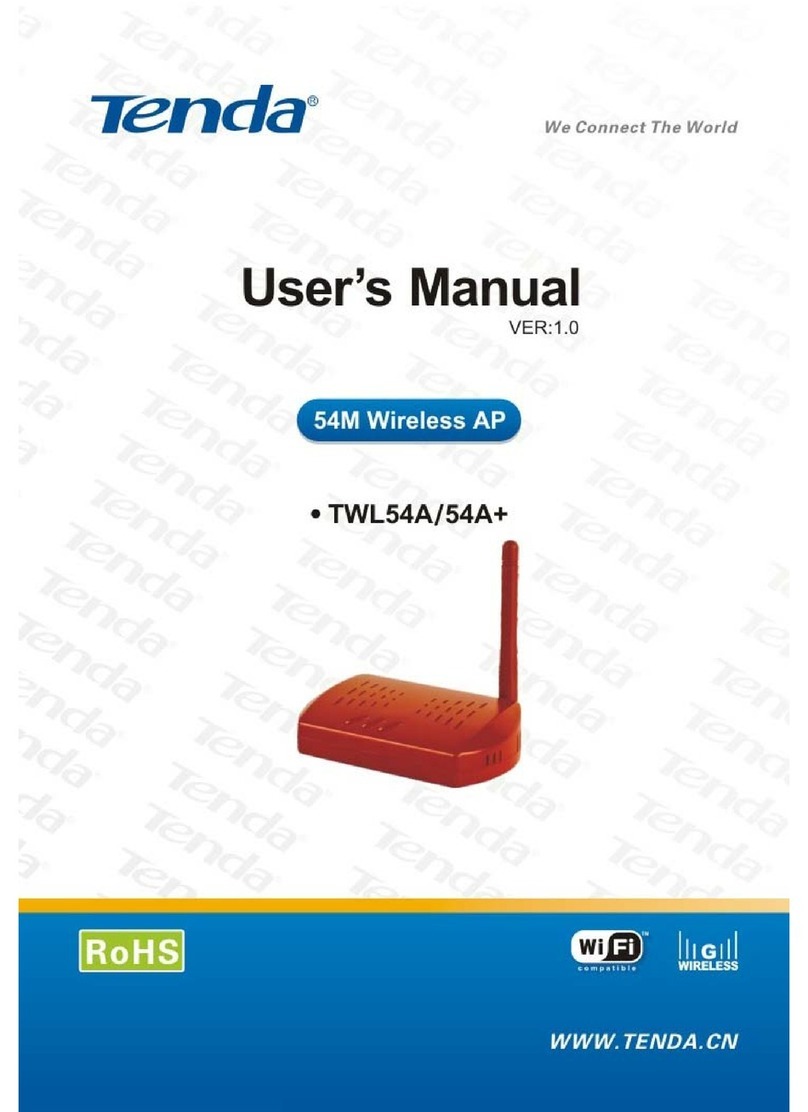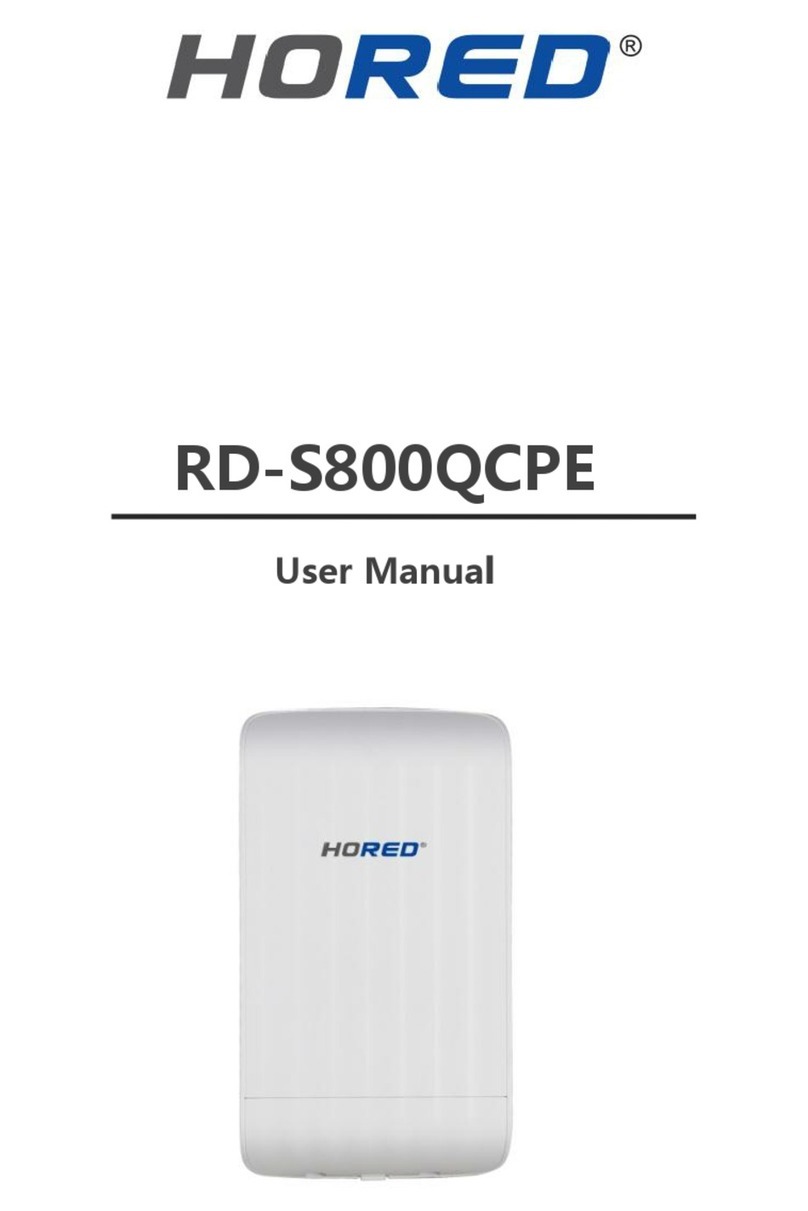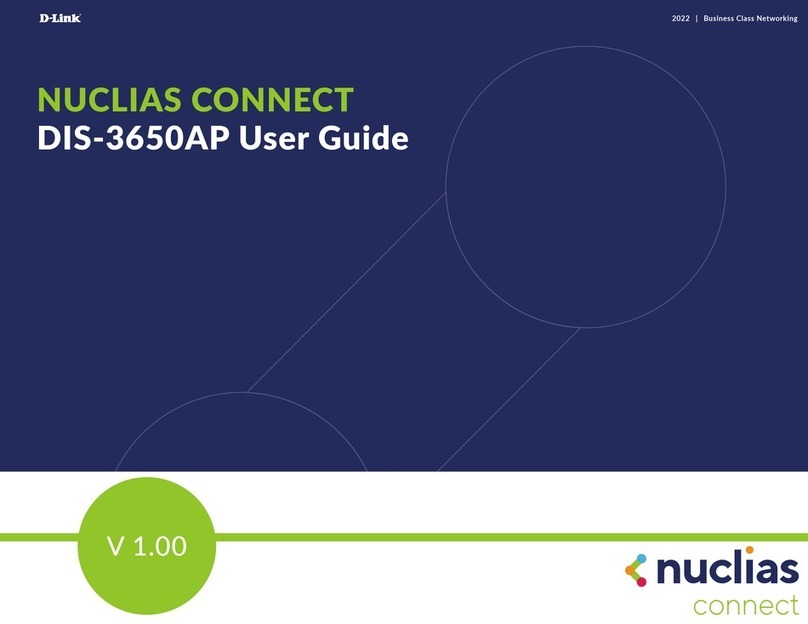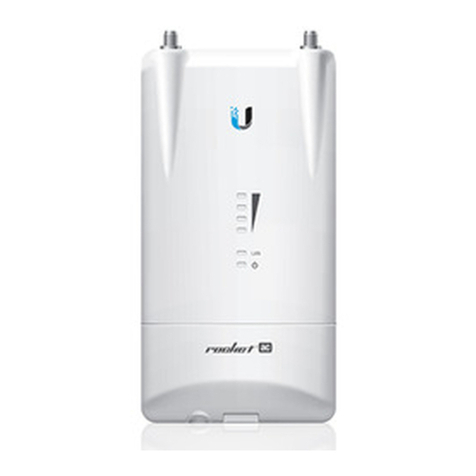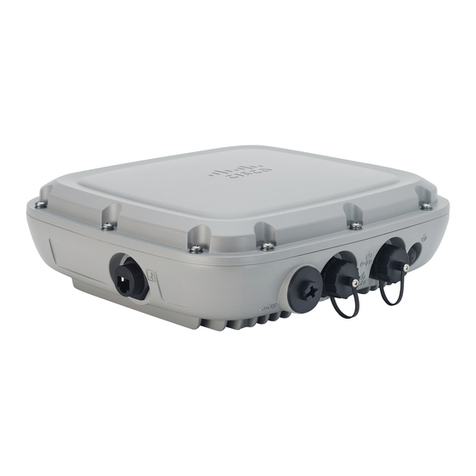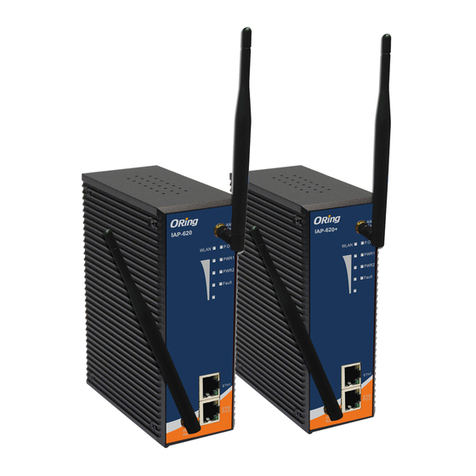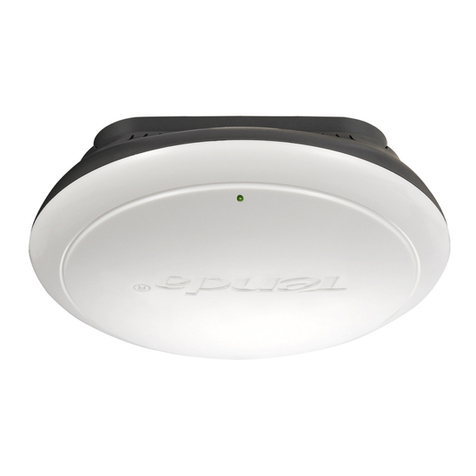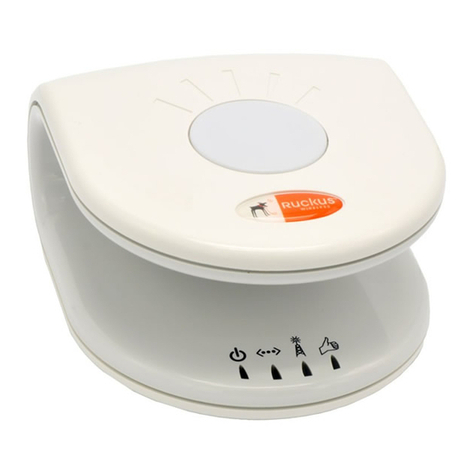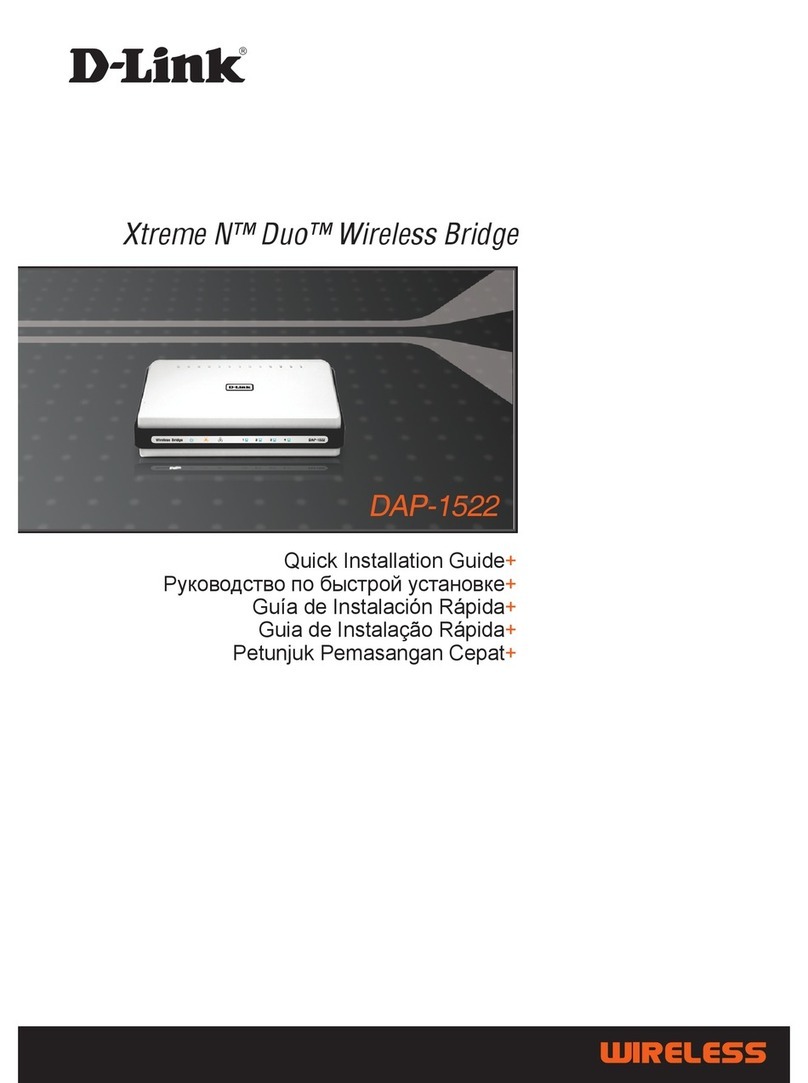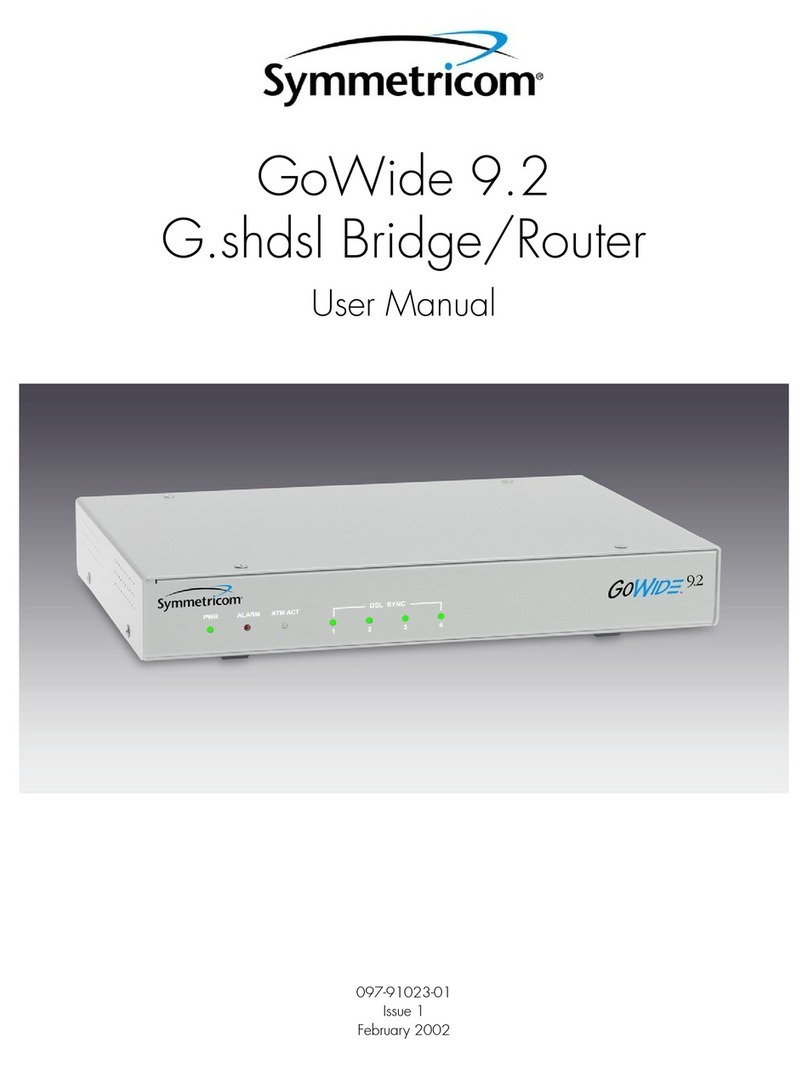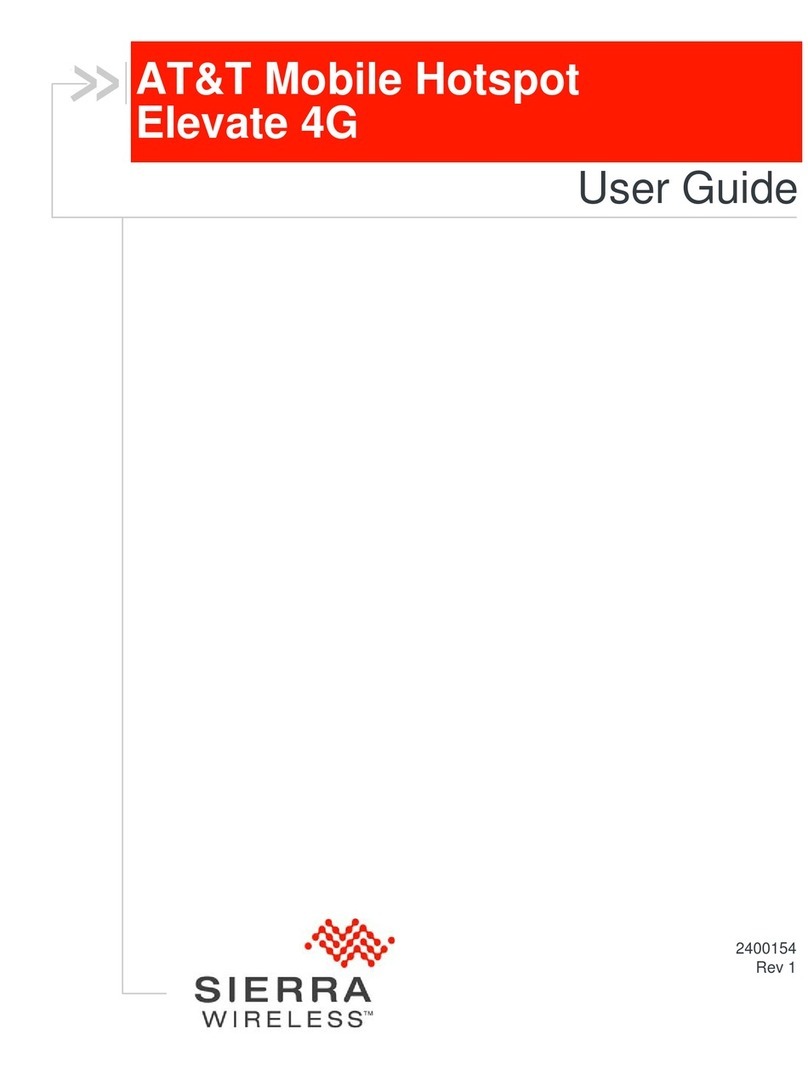Digital wireless SNAP2410 series User manual

SNAP2410/2414/2420
Spread Spectrum
Network Access Points
Installation Guide
April 20, 2000
One Meca Way
Norcross, Georgia 30093
www.digital-wireless.com
(770) 564-5540

Transmitter Module FCCID: HSW-2410M.
Note: This unit has been tested and found to comply
with the limits for a class A digital device, pursuant to
part 15 of the FCC Rules. These limits are designed to
provide reasonable protection against harmful
interference when the equipment is operated in a
commercial environment. This equipment generates,
uses, and can radiate radio frequency energy and, if not
installed and used in accordance with the instruction
manual, may cause harmful interference to radio
communications. Operation of this equipment in a
residential area is likely to cause harmful interference
in which case the user will be required to correct the
interference at his own expense. Commensurate with
EIRP limits specified in FCC Rules 15.247b, this
device may not be used with antennas that exceed
36dB of gain in point-to-point applications or 16dB of
gain in multi-point applications.

Table of Contents
Introduction...................................................................................................... 1
Getting Started................................................................................................. 2
Connecting the SNAP.................................................................................... 2
SNAP Status Indicators ................................................................................. 3
Configuring the SNAP.................................................................................... 3
SNAP Operation............................................................................................... 5
Overview....................................................................................................... 5
TCP/IP Addresses......................................................................................... 5
Seamless Roaming........................................................................................ 6
Synchronization............................................................................................. 7
AP Mode Operation....................................................................................... 7
PPP Operation .............................................................................................. 8
4-Port Hub..................................................................................................... 8
SNAP Command Set........................................................................................ 9
SNAP System Commands............................................................................. 9
Ethernet Commands.....................................................................................10
SNAP Radio Commands...............................................................................11
AP Mode Commands....................................................................................12
PPP Mode Commands .................................................................................13
Radio Modem Configuration ............................................................................15
Radio Commands.........................................................................................15
SNAP Datagram Protocol (SDP)......................................................................17
Overview......................................................................................................17
SDP Header.................................................................................................17
SDP Messages.............................................................................................18
Troubleshooting ..............................................................................................21
Technical Support.........................................................................................21
Quick Reference..............................................................................................22
Specifications..................................................................................................25
Warranty.........................................................................................................26

2000 Digital Wireless Corporation 1042000
INTRODUCTION
The SNAP2410 family of products from Digital Wireless Corporation provides Ethernet
connectivity to networks of WIT2410 radios. Built around the WIT2410, SNAP products
provide a 10BaseT connection to Ethernet networks and function as base stations for
remote devices containing WIT2410 transceivers. By supporting seamless roaming,
multiple SNAPs can be connected to a network to provide practically unlimited coverage
area. To simplify system installation some SNAPs have built-in 4-port hubs with an
uplink port. In addition, these SNAPs allow for power to be distributed through the hub
ports.
Depending on the model, SNAPs have one or two WIT2410 transceivers. Each radio can
support 62 simultaneous remotes. Thus SNAPs can support up to 124 simultaneous
remotes. Each remote radio has a unique ID number, so the number of remotes that can
communicate with a SNAP is unlimited, subject to a limit of 62 remotes at any one time.
The communication between the SNAP and the WIT2410 remotes is performed using the
WIT2410 over-the-air protocol. Thus the SNAP products are 802.3 compatible but not
802.11 compatible. By using the 460Kbps over-the-air data rate the WIT2410 protocol,
the full range of WIT2410 radios is realized, three times the range of most 802.11
products.
The SNAPs enjoy the same benefits of frequency-hopping spread spectrum technology
that the WIT2410s do. Namely, the immunity to multipath fading and resistance to
jamming that is provided by changing frequency every few milliseconds. Operating in the
2.4GHz ISM band, SNAPs can be used license-free worldwide and are not subject to the
congestion in the 900MHz band caused by cordless telephones.
The SNAP has two modes of operation, AP and PPP. The default mode is the AP mode.
In this mode the SNAP uses a special protocol mode called SDP(SNAP Datagram
Protocol). In order to send receive or transmit data from the SNAP, the application
software must use this protocol. The user may use the API roam library included with
the SNAP to help shorten software development.
The SNAP can also be configured as a PPP server. This allows any computer with a
remote to connect to the same network as the SNAP. These computers then could access
any files on the network and support browser-based applications.

2000 Digital Wireless Corporation 2042000
GETTING STARTED
The SNAP family of wireless Ethernet modems are easy to install and operate. In most
instances, the only installation steps will be setting IP addresses, selecting one modem as
the master and connecting the antenna, power and Ethernet cable.
Connecting the SNAP
Figure 1 identifies the various connectors on the rear of the SNAP2410.
Figure 1. SNAP Rear Panel Diagram
The antenna connector is a TNC type connector. An antenna may be connected directly
to this connector. Alternatively, an antenna may be located away from the SNAP using
RF cable to connect the SNAP to the antenna. Digital Wireless does not recommend
using RF cables longer than 5 feet. If more distance is required between the SNAP and
the antenna, high-quality, low-loss RF feed line must be used.
The 10BaseT Ethernet connector is the standard RJ-45 connector. The connector is wired
to be able to connect directly to an Ethernet hub using a straight-through cable. If it is
desired to connect the SNAP directly to a PC without a hub, the SNAP must be
connected with a cross-over cable.
The synchronizing signals are provided for special applications where multiple master
SNAPs are employed in an environment with slave SNAPs that are moving. The
synchronizing signals are RS-485 levels and may be connected using an RJ-11 connector.
In most instances the synchronizing signals are not required and may be left unconnected.
The power connector is a 2-pin DIN type connector. The provided AC adapter provides a
9 volt power level to the SNAP. The SNAP can accept DC voltages ranging between
7VDC and 26VDC if alternative power supplies are to be used.
Power Connector Synchronizing Signals 10BaseT Ethernet Connector
TNC Antenna Connector

2000 Digital Wireless Corporation 3042000
Figure 2. SNAP2410 Front Panel Diagram
The Configuration Port is an RS-232 serial port that may be used to configure the SNAP.
This is useful when the default IP address of the SNAP cannot be used with the existing
network preventing configuration through a telnet session. See the section Configuring
the SNAP for details of using this port.
SNAP Status Indicators
The PWR indicator on the front panel indicates that power is applied to the SNAP and
that the power switch is in the ON position.
TXD and RXD are indicators of data activity. They indicate the transmission and
reception of data over the Ethernet connection. Note that these LEDs can be active even
when the SNAP has no remote radios registered.
The COLL indicator is illuminated whenever packets collide on the network segment to
which the SEM is connected. As such, this is rough indicator of the level of traffic on the
network segment. If this LED is glowing brightly on a continuous basis, the throughput
of the SEM may appear to be reduced.
The LINK indicator when illuminated indicates a good connection to the Ethernet
network. If this LED is not on, it can indicate a cross-wired connection between the
SNAP and the network. It may also indicate a faulty cable connection.
Configuring the SNAP
SNAPs are shipped from the factory with default settings that include a default IP address
of 192.168.0.254. The network that the SNAP is connecting to must be compatible with
10BaseT products. The SNAP will not work if the network only supports 100BaseT
products. Before connecting a default configured SNAP to an active network, ask the
network system administrator to make sure that the default IP number will not cause any
SNAP 2410
2.4 GHz SPREAD SPECTRUM WIRELESS ETHERNET MODEM
Power Switch Status Indicators Configuration Port

2000 Digital Wireless Corporation 4042000
problems on the network and that the SNAP will be recognized by the network. If the
default IP address conflicts with a device on the existing network, the SNAP will need to
be configured through the serial port.
The SNAP can be configured two ways. The first is through the serial port. The settings
for the serial port are 38400 baud, 8 data bits, 1 stop bit, and no parity. WinSNAP will
automatically find the appropriate serial port and configure the serial port settings for
you. The software will inform you of its progress and any problems that arise. After a
few seconds the SNAP firmware version is displayed followed by the SNAP> prompt.
The second configuration method is through a telnet session. Most telnet programs work
with the SNAP. Windows 95/98/NT/2000 have a telnet program that works with the
SNAP. If there are no conflicts with the default IP number, initiate a telnet session to the
SNAP. A telnet session can be started by clicking on Start->Run if you have Windows
95/98/NT/2000 and the TCP/IP client has been installed. Enter the following information
in the dialog box:
telnet 192.168.0.254
A telnet window will open up. The first line is the version of the SNAP firmware
followed by the prompt:
SNAP>
To change the IP number of the SNAP, use the ip command.
ip <xxx.xxx.xxx.xxx> {yyy.yyy.yyy.yyy}
Where x is the new IP address, and y is the optional netmask number.
Store the changed configuration parameters in non-volatile memory with the save
command:
save<CR>
The SNAP will report back the time it took to the save the information. Reset the SNAP
by typing:
reset<CR>
The SNAP can also be reset by cycling power. Whenever a reset is executed on the
SNAP, the telnet session will be lost. It will take the SNAP about 30 seconds to
reinitialize after a reset or after cycling power.
Note: The save and reset commands must be entered after modifying the
default configuration. Failure to do so will result in the factory defaults to
be used.

2000 Digital Wireless Corporation 5042000
SNAP OPERATION
Overview
At the most basic level, SNAPs can be thought of as Ethernet-to-serial interface adapters.
That is, they take data from a host application over a 10BaseT Ethernet connection,
remove the Ethernet header information, format the data for WIT2410 radios and
transmit the data to the on-board WIT2410 through a high-speed serial interface. In the
other data flow direction, the on-board WIT2410 receives data from a remote WIT2410
device. The SNAP takes this data and provides the necessary Ethernet datagram
encapsulation and transmits the datagram to the host application over the connected
network.
A SNAP can be used standalone, or a group of SNAPs can be connected together through
a 10BaseT hub to provide seamless roaming over a larger area. When seamless roaming
operation is desired, the SNAPs must be synchronized with each other. This
synchronization is accomplished either over the Ethernet network or through a
differential Sync signal when time delay devices (such as routers) are between SNAPs.
See the section on Synchronization for details.
Communication between the host application SNAPs can occur at one of two levels.
Provided with the SNAP is a library of C routines that constitute a high level API for
workstation-based applications. Alternatively, host applications can communicate with a
SNAP using the SNAP Datagram Protocol (SDP). This protocol is described in detail
later in this manual.
The SNAP has a serial Configuration port in addition to the 10BaseT port. This port
allows configuration of the SNAP without having to connect it to a network. The
WinSNAP configuration utility provided with the SNAP is used to configure the SNAP
through the serial Configuration port. Any configuration of the SNAP can be performed
using either the Configuration port or over the network.
TCP/IP Addresses
Each SNAP must be configured with a unique IP address that is appropriate for the
network where the SNAP will be used. The IP address can be set using the ip command
through the serial-port interface. The ip command takes one or two parameters. The first
parameter specifies the IP address for the SNAP, and the second optional parameter, if
present, specifies the netmask for the SNAP. If the second parameter is not used, the
netmask is set to the default netmask for the IP address specified. For example, the
command:
ip 192.168.0.1
will set the SNAP’s IP address to 192.168.0.1 and the netmask will remain
255.255.255.0.

2000 Digital Wireless Corporation 6042000
The command:
ip 192.168.1.233 255.255.255.192
will set the SNAP’s IP address to 192.168.1.233 and will change the netmask to
255.255.255.192. The ip command without any parameters will display the current
setting of the IP address and netmask. The SNAP includes a simple ping command that
can be used to test the IP address and routing table settings.
The SNAP can also obtain its IP address from a BOOTP server if one is present in the
network. The BOOTP server will require the Ethernet hardware MAC address to be able
to assign the IP address to the SNAP. The Ethernet hardwate MAC address of the SNAP
is configured as 00:30:66:XX:YY:ZZ, where XX:YY:ZZ is the unique ID of the SNAP’s
“radio A”.
The route command can be used to modify and display the IP routing table entries. To
display the routing table, use the route list command. There will always be one entry in
the routing table that corresponds to the IP address of the SNAP. For most applications,
if any routing table entries are required, it will be sufficient to set a default route. To set
the default route, use the command:
route add default <gwaddr>
where <gwaddr> is the IP address of the default gateway (usually a router or routing
host). To remove the default route, use the command “route del default”. To add a route
to a particular network or host, use the command “route add <dest> <gw> [<netmask>]”,
where “<dest>” is the destination network or host IP address, “<gw>” is the IP address of
the gateway, and the optional “<netmask>” is the netmask which defines the destination
network.
Seamless Roaming
The SNAP2410 allows remote radios to seamlessly roam between multiple SNAP2410.
The remote radios can also be configured not to roam if this is the required operating
condition. In order for the remote to be able to roam seamless the <wg> parameter must
be set to 2. When the RSSI (receive signal strength indictor) of the remote reaches a
certain threshold, the remote will start looking for another SNAP with a higher RSSI.
The SNAP will be notified with a CONNECT and DISCONNECT packet when a remote
leaves or connects with a SNAP.
To facilitate seamless roaming among a group of SNAPs, the SNAPs use Ethernet
packets to synchronize time relative to each other. A single “master” SNAP will
broadcast (or multicast) special UDP datagrams to the “slave” SNAPs to deliver timing
information through the network. The SNAPs can also synchronize with one another by
RJ-11 cable (telephone cable). The RJ-11 method of synchronization uses a daisy chain
fashion to connect the SNAPs together. The SNAPs need to be synchronized this way if

2000 Digital Wireless Corporation 7042000
the ethernet packets can not be transmitted in a timely manner, such as going through a
router.
Synchronization
The SNAP uses broadcast or multicast datagrams for time synchronization. The default
is for the master SNAP to broadcast datagrams to the 255.255.255.255 all-hosts IP
broadcast address. Using the “sys xcast <ipaddr>”, SNAPs can be configured to use a
more limited IP broadcast address, or a multicast address. All SNAPs in a network
should be configured with the same “xcast” address. The use of multicast addresses is
preferred so that synchronization datagrams do not interfere with hosts other than the
SNAPs. Note that the SNAPs use UDP port 2410 as the source and destination UDP port
numbers in the synchronization packets.
The command “sync master” is used to set a SNAP to the master for time
synchronization, and the command “sync slave” is used to set a SNAP to be a slave for
time synchronization. There should be one master in a given network, even if there is
only one SNAP in the network.
There may be a time when there will be SNAP on different sides of a network router.
This situation could cause the SNAPs not to be synchronized. This is where the RJ-11
sync connectors can be used. If the remotes will need to be able to roam between the
SNAP located on different sides of the network router, the SNAP will have to be
connected together using the RJ-11 connectors. The cable will only need to be two
twisted pair. This is the same as regular phone cable. If there are more than two SNAPs
in the network, the SNAPs will need to be daisy chained together.
AP Mode Operation
The default operating mode of the SNAP is AP mode. This mode is optimized for
communications between a workstation or workstations on an Ethernet network and a
network of WIT2410-based devices. The AP mode assumes that there is limited
intelligence in the remote host. The AP mode is designed to allow the remote host
devices to send and receive data to the remote WIT2410 in transparent mode.
Data exchanges between the SNAP and workstations on the network are made using the
SDP protocol. This protocol is described in detail later on in this manual. To shorten
software development time, a C library is included that will help with the SNAP protocol.
roamlib will help in the developing the software needed to talk to the remote radios from
the SNAP. Also included is a simple multi-window (one per remote) ethernet chat
program, roam.exe. This program allows the user to send data to the SNAP and to the
remote. This program is based on the roamlib. In order for roam.exe to work the “sys
xcast” must be 224.5.5.5, the “sdp” must be 224.1.2.3 and the source and destination port
numbers must be 2411 and 2412 respectively. These are the default settings. Using the
roam library requires the use of winsock.dll. This file should already be included on any
Windows 95/98/NT PC that has TCP/IP installed as a protocol.

2000 Digital Wireless Corporation 8042000
PPP Operation
The SNAP can be configured to operate as a PPP (Point-Point Protocol) server. PPP is a
dial-in network connection that allows TCP/IP communication. A PPP connection allows
a remote connected to a computer to be connected to network that the SNAP is on using
the TCP/IP protocol. In order to operate the SNAP as a PPP server, the following
sequence of commands must be entered.
sys mode PPP
save
reset
The SNAP will also allow the user to specify the starting IP address for the remotes that
logon. The first remote to logon will receive the IP address specified below. The SNAP
will then add one to the IP address for the next remote to login.
ppp base <IP address>
Included in the appendix is a listing of a Windows modem definition file. This inf file
will work on Windows 95/98/2000/NT for a remote WIT2410 modem device connected
to a serial port. The WIT2410-based modem device needs to be added as a new modem
using the standard Windows procedures. When installed, Windows dial-up networking
can be used to create a PPP session between the remote PC and the SNAP. The PPP
mode of the SNAP also works with various versions of UNIX and LINUX. Contact
Digital Wireless Technical Support for details.
4-Port Hub
The SNAP2414 model includes a built-in 4-port hub. Even though there are 5 ethernet
ports, only four of them can be used. There is an uplink port that can be used to connect
to another SNAP or hub. This uplink port is connected to the 4th ethernet port. The hub
will not work correctly if a connection is made to both of these ports. This hub will only
support 10BaseT networks.

2000 Digital Wireless Corporation 9042000
SNAP COMMAND SET
The SNAP supports a series of commands that allow for configuring the Ethernet
interface as well as the radio parameters of the on-board WIT2410. These commands can
be entered during a telnet session or by using the WinSNAP24 utility when the SNAP>
prompt is displayed. The commands are summarized here with detailed explanations
following.
SNAP System Commands
Command Description
echo Toggles user screen echo mode
help Displays command help screen
reset Resets the SNAP activating changed configuration
parameters
save Stores current configuration to memory
sys [help
mode [AP|PPP]
outmax <1-212>
xcast [<b/mcastaddr>]
Displays help screen for command
Sets SNAP to Access Point or PPP server mode
Set maximum transmit packet length
Shows broadcast/multicast address
Sets broadcast/multicast address
version Diplays SNAP firmware version
echo Toggles the user screen mode to echo characters typed by the user. Default is
on. If echo is turned off, characters typed will not be displayed on the screen
unless echoed by the terminal program.
help Displays a list of all the SNAP commands. Most commands that require a
parameter also have a help mode that displays the help screen for that
command.
reset Resets the SNAP and loads saved parameters into active memory. Also
causes the SNAP to reinitialize which can take 30 seconds. If reset is issued
before the save command, the new parameters are lost and the last saved
parameters are used.
save Saves changed parameters in non-volatile memory to be loaded on power up.
Must be issued before the reset command or cycling power to have changed
parameters take effect. (An exception is the sys outmax command which
becomes active immediately after it is entered.)
sys These commands modify system operation parameters. The mode
subcommand is used to select the AP or PPP mode of operation. outmax sets
the length in bytes of the packets the processor in the SNAP will send to the
internal radio. This value cannot be longer than the pktlen value set in the
radio. Refer to the section on radio commands for details of the Set Base Slot

2000 Digital Wireless Corporation 10 042000
Size command. The xcast subcommand is used to set the multicast address to
be used when the SNAP puts data out on the network.
version Displays the SNAP firmware version.
Ethernet Commands
Command Description
arp –a
-d <ipaddr>
-s <ipaddr> <eaddr>
Displays arp table
Deletes arp entry
Adds arp entry
ip [ <ipaddr> <netmask>]
Displays current SNAP IP address
Sets SNAP IP address and optionally the netmask
password Sets password for telnet sessions
ping <ipaddr> Pings TCP/IP host
route [ help
add <ipaddr|default> <gwaddr>
<netmask>
del <ipaddr>
list
Displays help screen for command
Adds IP address and netmask to route list
Deletes IP address fromroute list
Lists route IP addresses
socks Displays network socket information
arp Manipulates the address resolution procedure table. This command is
provided primarily as a debugging tool for setting up networks. ipaddr is the
device IP address and eaddr is the physical Ethernet address of the device
ip Sets the IP address of the SNAP. The default IP address is 192.168.0.254.
When specified netmask sets the netmask number. The default netmask is
255.255.255.0.
password Allows a password to be set to restrict the ability to initiate telnet sessions
with the SNAP. When this command is entered, the user is prompted for a
new password which is then prompted for a second time for verification. If
this password is forgotten, a new password must be entered through the
configuration port.
ping sends inquiry packets to TCP/IP host specified in <ipaddr> and displays the
amount of time that elapsed before a response was received. Continuously
sends requests until a key is pressed.
route Displays and manipulates gateway IP addresses to route IP traffic off the
subnet. Default sets the default gateway IP address. When an IP address is
entered instead of default, the gateway IP address specified will be used only
for traffic destined for that IP address. The route table always has an entry
associated with the IP address assigned to the SNAP.
socks Displays the network socket information.

2000 Digital Wireless Corporation 11 042000
SNAP Radio Commands
Command Description
hop [help
length <hoplen>
sequence [75|25]
Displays help screen for command
Informs SNAP of radio hop dwell time
Informs SNAP of number of frequencies in radio hop
pattern
radio [A|B] [ help
banner
network
cfg]
Displays help screen for command
Displays the banner of the specified radio
Displays the network number (wn) of specified radio
Enters radio command mode
remote [help
list
send <handle> <data>]
Displays help screen for command
Displays remotes currently registered with the SNAP
Sends data to the remote specified by the handle
sync [help
ether
master
override
settings
slave
wire]
Displays help screen for command
Sets synchronization mode to use Ethernet packets
Sets SNAP as synch master
Toggles master backup override
Displays synchronization settings
Sets SNAP as synch slave
Sets synchronization mode to use RS-485 wire ports
hop Used to inform the SNAP of the hop dwell time or the number of frequencies
in the hop pattern of the radio in the SNAP. The parameter entered for
length is in 625µs increments. The hop time specified by length should
agree with the time specified by the ph parameter in the radio. ph is the
hexadecimal value of the number of 69.4 µsec ticks in the dwell time. Thus
for each increment in length, the ph parameter should be increased by 9. A
value of 16D corresponds to a hop dwell time of 10 msec and is the default.
The sequence is the number of hop frequencies in the hop pattern in the
radio in the SNAP. The default is 75 for US/ETSI operation. All other
frequency bands, as set in the radio by the pe command, have 25 frequencies
in their hop patterns. This value is entered as a decimal number. Neither the
length nor the sequence need to be modified unless they are modified in the
radio in the SNAP.
radio Displays information about the configuration of the radio in the SNAP or
puts the radio in configuration mode. Aor Bmust be specified to identify to
which of the two possible radios in the SNAP the command is directed. The
banner command returns the firmware version number and the serial number
of the radio in the SNAP. When cfg is entered, the specified radio is put into
configuration mode. The SNAP> is replaced with just a > prompt. At this
point radio configuration commands may be entered. Refer to the section on
radio commands in this manual for the radio commands pertaining to the
SNAP. Refer to the WIT2410 Integration Guide for a complete listing of
radio commands.

2000 Digital Wireless Corporation 12 042000
remote This command lists the currently registered remotes by the serial number of
the remote radio and the assigned handle. The send subcommand will send
the specified data to the remote with handle specified in the command. This
is intended as a debugging mode and not an operational mode.
sync These commands set the operation of the synchronization signal used in
multi-SNAP networks implementing seamless roaming. ether and wire are
mutually exclusive commands and set the synchronization to occur over the
Ethernet or over the RS-485 signal lines. One SNAP must be configured as
the sync master and all others must be configured as sync slaves. override
toggles the master backup override on and off.
AP Mode Commands
These commands are unique to the AP mode of operation. Each command is preceded by
sdp.
Command Description
help Displays help screen for command
add <sdp> <ipaddr> <dstprt>
<srcprt> Add an SDP entry
cache <size> Set number of cached SDP output packets
delete <sdp> Delete an SDP entry
list List SDP entries
sdp
max <size> Set SDP maximum packet size
help Lists the various commands available under the sdp top level command.
add Defines the IP address and port numbers that the SNAP will use when sending
and receiving SDP messages. A maximum of 4 SDP entries may be set up.
They can be either unicast or multicast addresses.
cache Allows the number of datagrams cached by the SNAP to be modified. Cached
datatgrams may be requested to be retransmitted by workstations.
delete Removes an SDP entry.
list List SDP entries and their associated IP addresses and port numbers.
max Sets the maximum number of bytes of data that will be included in a SDP
datagram before the datagram is sent. If 20ms elapses since the last byte
received, the datagram will be sent regardless of the number of bytes in the
datagram.

2000 Digital Wireless Corporation 13 042000
PPP Mode Commands
These commands are unique to the PPP mode. They are preceded by ppp.
Command Description
help Displays help screen for command
acct method
[local|radius]
Displays accounting method currently in use
Sets accounting method to local or Radius
auth method
[local|radius]
Displays authentication method currently in use
Set authentication method to local or Radius
base <ipaddr> Sets base IP address for SNAP
count <1-62>
Displays PPP base allocation count
Set to max number of remotes parameter of radio
radius help
add [auth|acct]
<ipaddr> [port]
delete [auth|acct] <ipaddr>
port [auth|acct] <ipaddr>
<port-number>
secret [auth|acct] <ipaddr>
<secret>
settings
Displays help screen for command
Adds IP address of Radius server for
authentication or accounting
Deletes IP address of Radius server
Sets the port number for a Radius server
Sets the secret for a Radius server
Displays Radius servers settings
status Displays status of registered users
timeout <time> Sets idle time timer in tenths of seconds
ppp
user help
add <usr>
delete <usr>
disable <usr>
enable <usr>
list
password <usr> <pwd>
Displays help screen for command
Adds a PPP user
Deletes a PPP user
Disables a PPP user
Enables a PPP user
List current PPP users, both enabled and disabled
Set PPP user password
help Displays the subcommands for the PPP mode.
acct Displays/sets the accounting method to be used for IP traffic. When set to
local, the SNAP keeps track of the amount of data traffic and time used by
each user. When set to radius, the accounting information is sent to the
designated accounting Radius server.
auth Displays/sets the authentication method to be used when users sign on. When
set to local, the password entered by the user when establishing the PPP
session must agree with the password entered for that user in the SNAP.
When set to Radius, the password entered by the user is sent to the
designated authentication Radius server.

2000 Digital Wireless Corporation 14 042000
base Sets base IP address for IP addresses to be assigned to remotes when in PPP
server mode. The base address is assigned to the first remote that registers
with the SNAP. The next remote to register is assigned the base IP address
incremented by one.
count Displays/sets the PPP base allocation count. This number must be equal or
larger than the maximum number of remotes the radio as it determines the
number of buffers the SNAP will set up to assemble SNAP datagrams.
radius These commands are used to set up one or more Radius servers to perform
authentication and accoutning functions. Separate servers may be used for
each function.
status This command displays the status for all currently registered users including
the IP address assigned to the user, the serial number of the remote radio, the
number of bytes and packets received and sent as well as bad packets.
timeout This command allows the SNAP to terminate the PPP session of an idle
remote after the specified amount of time. Time is specified in tenths of
seconds, thus a value of 600 corresponds to one minute. If the value is set to
zero, the timeout feature is disabled.
user Manipulates users that are entitled to connect to the SNAP. Also sets the
password for each entered user. usr and pwd can be any alphanumeric string
up to 32 bytes in length. When a new user is added, a password must be
assigned and the user must be enabled before access will be granted. A
password must be assigned even if a Radius server is to perform
authentication. There is no way to display passwords. If a password is
forgotten, a new password must be entered.

2000 Digital Wireless Corporation 15 042000
RADIO MODEM CONFIGURATION
The “radio” command provides access to several sub-commands that are useful in
configuring the WIT2410(s) in the SNAP. The format for the radio commands is radio
{A|B} <sub-cmd> [<sub-cmd-args>], where the {A|B} is either of the letters ‘A’ or
‘B’ used to specify to which radio the sub-command should be applied. The
SNAP2410/2414 uses only radio ‘A’ and the SNAP2420 uses both radios ‘A’ and ‘B’.
The command radio {A|B} banner can be used to display the banner from the radio.
This is useful in determining the unique ID of the radio and the version of firmware
running in the radio.
The command radio {A|B} cfg gives access to the configuration mode of the
WIT2410. When configuration mode is entered, the SNAP> prompt becomes just a >
prompt. To exit radio configuration mode, press the ESC key on the upper left portion of
the keyboard. The SNAP> prompt will return.
Radio Commands
The radios in the SNAP are set with factory defaults which should be sufficient for most
applications. For other applications, the following radio commands can be used to fine
tune the performance of the SNAP.
Command Description
dx [?|0-62] Set range optimization
ph [?|0-fe] (base only) Sets the hop duration in 69.4us increments.
90H = 10ms (default)
pw [?|0-35] (base only) Set Base Slot Size
35H = 212 bytes (default)
wn [?|0-63] Sets the network number (hopping pattern)
0= default
Set Range Optimization
For ranges in excess of 0.9 miles, this command optimizes the over-the-air timing to
provide the most robust communications. The diagram below illustrates how the
parameter works:
where xis 10 times the number of miles (mod 64) around which the 1.5 mile range is
desired.
Set Hop Duration
Sets the length of time the transceiver spends on each frequency channel. A smaller value
will allow the remote to lock on to the base signal faster at startup and will generally
decrease packet latency. A larger value increases network capacity due to decreased
overhead in channel switching. The hop duration is specified in 69.4us increments. The
x-0.6
x
x+0.9

2000 Digital Wireless Corporation 16 042000
default value of 90H corresponds to a duration of 10ms. The maximum value of FEH is
17.627ms. For best results do not specify a duration of less than 3ms. This value only
needs to be changed in the master SNAP radio which broadcasts the parameter to all
slave device radios. However, the SNAP command hop length <hoplen> must be used
to set the new hop duration in the SNAP processor of each slave SNAP. Initial link time
can be reduced if this value is set in the slave radios which will use it as a starting value
when scanning for a master.
Set Base Slot Size (master radio only)
Sets the amount of time allocated for transmission on each hop for the SNAP radio time
slot in 69.4us increments. Each increment corresponds to 4 bytes. Maximum value is 35H
which corresponds to 212 bytes. This is the default value and should only be changed to
provide more throughput for the slave device(s) at the expense of the master device
throughput.
Set Network Number (hopping pattern)
The radio in the SNAP has 64 preprogrammed hopping patterns or network numbers. By
using different network numbers, nearby co-located networks can avoid interfering with
each others’ transmissions. Even if both networks tried to use the same frequency, on the
next hop they would be at different frequencies.

2000 Digital Wireless Corporation 17 042000
SNAP DATAGRAM PROTOCOL (SDP)
Overview
The SNAP Datagram Protocol (SDP) is a UDP (datagram) protocol implemented in the
SNAP to communicate remote radio data to and from workstations on the network. The
use of UDP datagrams permits the SNAP to unicast, multicast, or broadcast remote radio
data to multiple workstations on the network. The SDP datagrams transmitted by the
SNAP are sequenced so that a receiving workstation can detect datagrams that do not get
delivered. The SNAP caches SdpCache number of datagrams so that a receiving
workstation can request a retransmit of a particular datagram. The number of cached
datagrams, SdpCache, defaults to eight and can be configured on the SNAP.
A specific unit of information regarding the SDP or a remote radio is referred to as a
“message” and are defined in detail below. Each SDP datagram consists of a header and
one or more messages. The sum of the lengths of the header and all of the messages
within the datagram will not exceed SdpMax bytes, which is a configurable parameter
and defaults to 512 bytes. The SNAP builds a datagram as the messages accumulate. As
the SNAP builds a datagram, if the next message to be added to the datagram will cause
the datagram to exceed SdpMax bytes in length, the datagram currently being built is
transmitted by the SNAP to all recipients. The SNAP then begins building a new
datagram with the current message. If 20 milliseconds elapse after the last message is
added to the datagram being built, then that datagram is transmitted by the SNAP to all
recipients. If there are no messages to send for 500 milliseconds after the last datagram
has been transmitted, the last datagram is retransmitted by the SNAP to all recipients. If
there are still no messages to send for 1 second after this, the last datagram is once again
transmitted by the SNAP to all recipients. The retransmission of the last datagram aids in
the detection of datagrams that fail to be delivered.
Datagrams that are sent by workstations to the SNAP(s) have a similar format to those
sent by the SNAP to the workstations. There is currently no provision for
acknowledgement or request-for-retransmit of datagrams sent by workstations to the
SNAP. One of the messages that a workstation may send to a SNAP in a datagram is
used to request the retransmission of a datagram. If the datagram indicated by the
sequence number in the request is currently cached by the SNAP, that datagram will be
transmitted by the SNAP directly to the host requesting the retransmission.
SDP Header
The header for an SDP datagram is eight bytes long. The first four bytes are a magic
number in network byte order which is used to identify/qualify the datagram. When
transmitting a datagram, the SNAP places the value SDP_SNAP_MAGIC in the magic
field of the header. When receiving a datagram, the SNAP expects the value
SDP_USER_MAGIC in the magic field of the header. The next byte is the sequence
number which increments for each datagram transmitted by the SNAP. The next three
bytes of the header are the unique-ID of the “radio A” for the SNAP.
This manual suits for next models
3
Table of contents
